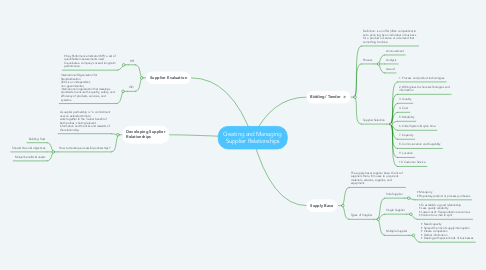
1. Supplier Evaluation
1.1. KPI
1.1.1. • Key Performance Indicator (KPI): a set of quantifiable measurements used to evaluate a company’s overall long-term performance.
1.2. ISO
1.2.1. International Organization for Standardization (ISO) is an independent, non-governmental, international organization that develops standards to ensure the quality, safety, and efficiency of products, services, and systems.
2. Developing Supplier Relationships
2.1. A supplier partnership is “a commitment over an extended time to work together to the mutual benefit of both parties, sharing relevant information and the risks and rewards of the relationship.
2.2. How to develop successful partnerships?
2.2.1. Building Trust
2.2.2. Shared Vision & objectives
2.2.3. Mutual benefits & needs
3. Bidding/ Tender
3.1. Definition: is an offer (often competitive) to set a price tag by an individual or business for a product or service or a demand that something be done.
3.2. Process
3.2.1. Annoucement
3.2.2. Analysis
3.2.3. Award
3.3. Supplier Selection
3.3.1. 1. Process and product technologies
3.3.2. 2. Willingness to share technologies and information
3.3.3. 3. Quality
3.3.4. 4. Cost
3.3.5. 5. Reliability
3.3.6. 6. Order System & cylce time
3.3.7. 7. Capacity
3.3.8. 8. Communication and Capability
3.3.9. 9. Location
3.3.10. 10. Customer Service
4. Supply Base
4.1. The supply base/ supplier base: the list of suppliers that a firm uses to acquire its materials, services, supplies, and equipment.
4.2. Types of Supplier
4.2.1. Sole Supplier
4.2.1.1. • Monopoly • Proprietary product or process purchases
4.2.2. Single Supplier
4.2.2.1. • To establish a good relationship • Less quality variability • Lower cost • Transportation economies • Volume too small to split
4.2.3. Multiple Supplier
4.2.3.1. • Need capacity • Spread the risk of supply interruption • Create competition • Gather information • Dealing with special kinds of businesses
